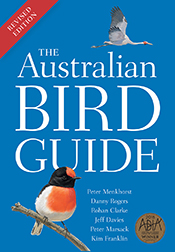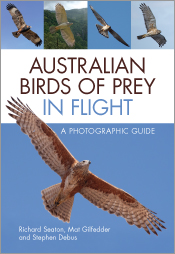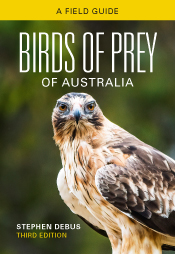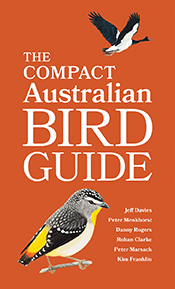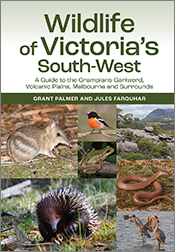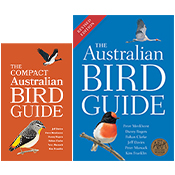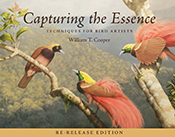The Australian Bird Guide

Revised Edition By: Peter Menkhorst, Danny Rogers, Rohan Clarke, Jeff Davies, Peter Marsack, Kim Franklin
The most comprehensive and beautifully illustrated field guide to Australia’s unique birdlife.
Australia's avifauna is large, diverse and spectacular, reflecting the continent's impressive range of habitats and evolutionary history. With specially commissioned paintings of over 900 species, The Australian Bird Guide is the most comprehensive field guide to Australian birds ever seen. + Full description
This Revised Edition includes updated maps, artwork and species accounts, reflecting current knowledge of the biology and distribution of Australia's birds. It features around 4700 specially commissioned colour illustrations of over 900 species, with particular emphasis on providing the fine detail required to identify difficult groups and distinctive plumages. Comprehensive species accounts have been written by a dedicated team of ornithologists to ensure identification details, distribution and status are current and accurate. A new easier-to-use index is also included.
The Australian Bird Guide sets a new standard in field guides, providing an indispensable reference for all birders and naturalists looking to explore Australia's magnificent and unique birdlife.
Winner, The 2017 RZS NSW Whitley Medal
Winner, The 2018 Australian Book Industry Awards: Small Publishers' Adult Book of the Year
News
Sales in Australia and New Zealand only. Elsewhere, this title is available through Bloomsbury Publishing (external link).
Check out The Compact Australian Bird Guide (August 2022), a quick identification guide based on The Australian Bird Guide.
Watch a Facebook video (external link) featuring artwork from the book.
Reviews
"Like looking through a new pair of binoculars, The Australian Bird Guide makes it seem like you are seeing even familiar birds for the first time."
Sean Dooley, Editor, Australian Birdlife
"This field guide is an invaluable reference for anyone with an interest in this country’s birdlife."
Gardening Australia, November 2019
"Books, such as The Australian Bird Guide, are important for the conservation of Australia’s flora and fauna; they bring nature to people and enable everyone to identify and take joy in the birds, other animals, and plants that we share the world with."
Harry F. Recher, Pacific Conservation Biology 26(1) 2020
Reviews of the First Edition (May 2017):
"a gorgeous lure to spend more time in nature."
Susan Wyndham, "2017 Books of the Year", Australian Book Review #397, December 2017
"The illustrations are amazing. Each is the purest and most accurate depiction of a species possible: the absolute platonic ideal of itself... [This book] makes me yearn — to see more birds, to note obscure plumage details, to plan holidays to see farther-flung species. This book reinvigorates my love of birds and birding and makes clear how lucky we are to have such amazing riches. And that is some powerful art."
Kate-Gorringe-Smith, Australian Birdlife, June 2017
"Not only does The Australian Bird Guide successfully provide a rich, contemporary bird identification book, it has the potential to play a far more significant cultural role – in cataloguing the full extent of the glorious variety of Australian birds it becomes a palpable celebration of the wonder of nature."
Sean Dooley, Sydney Morning Herald online, 28/7/17
"If you are looking at getting a field guide to the birds of Australia, the ABG is undoubtably the best."
Michael Szabo, Birds New Zealand (14), June 2017
"Compared with all other Australian bird guides, the text and most of the illustrations are on a higher level... The cornucopia of high quality illustrations – including numerous smaller sketch-ups illustrating such things as foraging behaviours, honeyeater corroborees, and size comparisons with similar possible species – puts the guide in the upper echelon of bird guides globally... For me, this volume by Menkhorst and colleagues has become my new favourite."
Eliot Miller, Emu - Austral Ornithology 117(3), July 2017
"Birds are illustrated in poses that best highlight diagnostic features. Seabirds are depicted almost exclusively in flight, precisely as most will encounter them at sea. The text is detailed without being too over-the-top, featuring all of the expected information and including helpful notes on recent taxonomic changes, distributional information that might be too granular to identify on the maps, and behavioural notes which might assist finding the bird and separating it from confusing species. The maps are clear and show all subspecies."
Chris Watson, Australian Birdlife, June 2017
"the ABG is undeniably the most comprehensive field guide to be published in Australia to date, surpassing previous guides in the quantity and accuracy of illustrations and pertinent information."
Richard Noske, Australian Book Review, October 2017
Details
Paperback | August 2019 | $ 49.99ISBN: 9781486311934 | 576 pages | 245 x 170 mm
Publisher: CSIRO Publishing
Colour Paintings, Maps
Features
- Superb, specially commissioned artwork that provides a level of fine detail not found in any other Australian guides
- 4700+ detailed paintings illustrating species variations
- Coverage of all species and distinctive subspecies recorded in Australia and its external territories, using the latest taxonomy
- Indexed by both the common and scientific names
Contents
ForewordAlphabetical quick reference to bird groups
Acknowledgements
Constructing the guide
Identifying birds
Birding in Australia
A guide for birders to the evolution and classification of Australian birds
Key to abbreviations and symbols
Species accounts
Checklist of species
Glossary
Index
Authors
Peter Menkhorst became hooked on birding and natural history books when, as a seven year old, he used Cayley’s What Bird is That? to identify a New Holland Honeyeater in his garden; he is now a zoologist at the Arthur Rylah Institute for Environmental Research, Victoria. He is author, with Frank Knight, of A Field Guide to the Mammals of Australia (OUP 2001), editor and major contributor to the award-winning Mammals of Victoria (OUP 1995) and edited two editions of Pizzey and Knight’s Field Guide to the Birds of Australia (HarperCollins). He was awarded the Australian Natural History Medallion in 1998.
Danny Rogers started birding when he was four years old, and regrets those wasted first four years. Any birding is fun, but he has particular interests in the minutiae of plumage, moults and field identification, and in the ecology and conservation of shorebirds. He prepared many of the plumage sections in the Handbook of Australian, New Zealand and Antarctic Birds (OUP), did a shorebirds PhD in north-western Australia, has written or co-authored many papers and a couple of coffee-table books on shorebirds and is a waterbird ecologist at the Arthur Rylah Institute for Environmental Research, Victoria.
Rohan Clarke is an ecologist and ornithologist at Monash University. A birder since childhood, he has field experience with all but a couple of Australian species. He gets a kick out of birding remote island outposts and leading pelagic excursions to watch seabirds, as both present rich opportunities for new insight and discovery. He has previously authored Finding Australian Birds: A Field Guide to Birding Locations (CSIRO Publishing).
Jeff Davies is a lifelong birder who completed a Fine Arts Painting Major at Caulfield Institute of Technology. He has contributed artwork for Freshwater and Estuarine Fishes of Wilson's Promontory (Fisheries & Wildlife Div. 1983), Shorebirds of Australia (Nelson 1987), Handbook of Australian, New Zealand and Antarctic Birds (OUP) and The Penguins (OUP 1995). Jeff prefers to work with water-based mediums and commissioned works can be found in private collections in Australia and North America.
Peter Marsack trained as a zoologist but has also worked extensively as a natural history artist and illustrator. He was an artist for the multi-volume Handbook of Australian, New Zealand and Antarctic Birds (OUP), and a prize-winner in the inaugural Waterhouse Natural History Art Prize. His collaboration with Canberra naturalist Ian Fraser on A Bush Capital Year (CSIRO Publishing 2011) was awarded a Whitley Certificate for regional natural history.
Kim Franklin, BA (Fine Art) has had an interest in birds throughout his life. He has exhibited in Africa and Europe. His illustrations have featured in ornithological books including Handbook of Australian, New Zealand and Antarctic Birds (OUP), Birds of the Western Palearctic (OUP), Parrots (Pica Press), Raptors of the World (Helm), Birds of the Indian Subcontinent (Helm) and Pheasants, Partridges, and Grouse (Helm).

